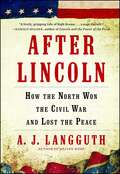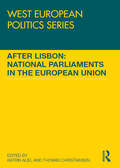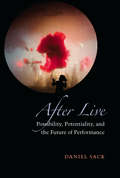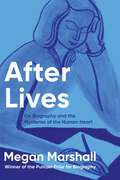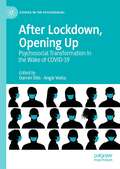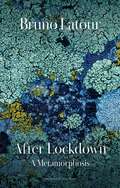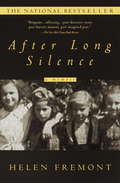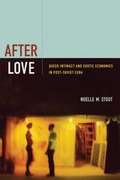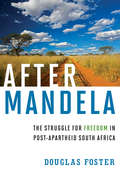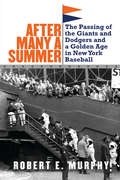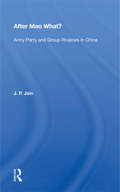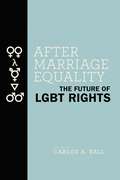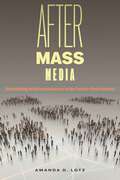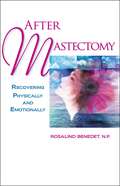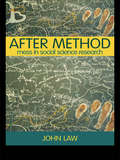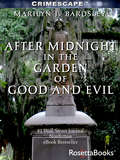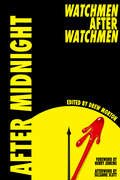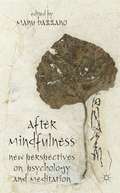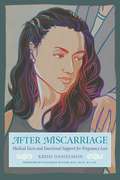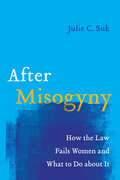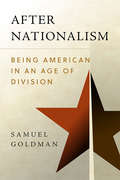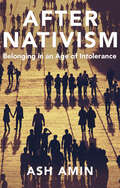- Table View
- List View
After Lincoln: How the North Won the Civil War and Lost the Peace
by A. J. LangguthA brilliant evocation of the post-Civil War era by the acclaimed author of Patriots and Union 1812. After Lincoln tells the story of the Reconstruction, which set back black Americans and isolated the South for a century.With Lincoln’s assassination, his “team of rivals,” in Doris Kearns Goodwin’s phrase, was left adrift. President Andrew Johnson, a former slave owner from Tennessee, was challenged by Northern Congressmen, Radical Republicans led by Thaddeus Stephens and Charles Sumner, who wanted to punish the defeated South. When Johnson’s policies placated the rebels at the expense of the black freed men, radicals in the House impeached him for trying to fire Secretary of War Edwin Stanton. Johnson was saved from removal by one vote in the Senate trial, presided over by Salmon Chase. Even William Seward, Lincoln’s closest ally, seemed to waver. By the 1868 election, united Republicans nominated Ulysses Grant, Lincoln's winning Union general. The night of his victory, Grant lamented to his wife, “I’m afraid I’m elected.” His attempts to reconcile Southerners with the Union and to quash the rising Ku Klux Klan were undercut by post-war greed and corruption. Reconstruction died unofficially in 1887 when Republican Rutherford Hayes joined with the Democrats in a deal that removed the last federal troops from South Carolina and Louisiana. In 1964, President Lyndon Johnson signed a bill with protections first proposed in 1872 by the Radical Senator from Massachusetts, Charles Sumner.
After Lisbon: National Parliaments in the European Union (ISSN)
by Katrin Auel and Thomas ChristiansenThe role of national parliaments in EU matters has become an important subject in the debate over the democratic legitimacy of European Union decision-making. Strengthening parliamentary scrutiny and participation rights at both the domestic and the European level is often seen as an effective measure to address the perceived ‘democratic deficit’ of the EU – the reason for affording them a prominent place in the newly introduced ‘Provisions on Democratic Principles’ of the Union (in particular Article 12 TEU). Whether this aim can be met, however, depends crucially on the degree to which, and the manner in which, national parliaments actually make use of their institutional rights. This volume therefore aims at providing a comprehensive overview of the activities of national parliaments in the post-Lisbon Treaty era. This includes the ‘classic’ scrutiny of EU legislation, but also parliamentary involvement in EU foreign policy, the use of new parliamentary participation rights of the Lisbon Treaty (Early Warning System), their role regarding the EU’s response to the Eurozone crisis, and the, so far under-researched, role of parliamentary administrators in scrutiny processes. This book was originally published as a special issue of West European Politics.
After Live: Possibility, Potentiality, And The Future Of Performance
by Daniel Aaron SackIn the dark of the blackout before the curtain rises, the theater holds its many worlds suspended on the verge of appearance. How can a performance sustain this sense of potentiality that grounds all live production? Or if a stage-world does begin, what kinds of future might appear within its frame? Conceiving of the theater as a cultural institution devoted to experimenting with the future, this book begins and ends on the dramatic sta≥ in between it traverses literature, dance, sculpture, and performance art to explore the various futures we make in a live event. After Live conceives of traditional dramatic theater as a place for taming the future and then conceptualizes how performance beyond this paradigm might stage the unruly nature of futurity. Chapters offer insights into the plays of Beckett, Churchill, Eno, and Gombrowicz, devised theater practices, and include an extended exploration of the Italian director Romeo Castellucci. Through the lens of potentiality, other chapters present novel approaches to minimalist sculpture and dance, then reflect on how the beholder him or herself is called upon to perform when confronted by such work.
After Lives: On Biography and the Mysteries of the Human Heart
by Megan MarshallA moving and penetrating memoir of a life in biography from the Pulitzer Prize winner and “gifted storyteller” (Judith Thurman, The New Yorker).Megan Marshall’s innovative books, including The Peabody Sisters and the Pulitzer Prize–winning Margaret Fuller, are treasured works of American biography. In the richly absorbing essays of After Lives, Marshall turns her narrative gift to her own art, life, and the people in it.In each of six essays, Marshall reinvents the personal essay form, as a portal to the past and its lessons for living into the future. The book’s brilliant, assured interplay between memoir and biography places surprising characters on the page, including the twelfth-century Buddhist hermit Kamo no Chomei, a reassuring spiritual presence for Marshall during several otherwise deracinating months in Kyoto. In her stunning coming-of-age tale, “Free for a While,” set in 1970s California, Marshall interweaves the story of her adolescence with that of Black Power martyr Jonathan Jackson, the author’s AP history classmate, gunned down at seventeen in a failed attempt to free his famed older brother George from prison in the case that put Angela Davis on the FBI’s Most Wanted list. Here too is the author’s passion for the biographical chase, and for the mysteries at its heart. She tells the astonishing story of viewing the disinterred remains of her one-time subject Sophia Peabody Hawthorne, wife of Nathaniel, and their daughter Una, the truths of whose early death Marshall works to reveal. Throughout these finely wrought essays, Marshall, “[at] the front rank of American biographers” (Dwight Garner, New York Times), makes palpable her driving impulse to “learn what I could from others: how to live, how not to live, what it means to live.”
After Lockdown, Opening Up: Psychosocial Transformation in the Wake of COVID-19 (Studies in the Psychosocial)
by Darren Ellis Angie VoelaThis edited volume examines the psychosocial transformations experienced during the COVID-19 pandemic and lockdown, and envisions those that might lead to a more equitable society as we ‘open up’. The book integrates psychoanalysis, sociology, cultural studies, and psychology to address three main areas: personal experiences of the lockdown, new formations of power and desire that the lockdown has shaped, and global concerns related to the pandemic. Within those three areas, the chapters discuss key themes that include the uses of space during lockdown; experiences of death, loss, and domestic violence; race and the pandemic; technology, media, and viral media; chronic illness; handwashing and COVID-19; and conspiracy theories.Drawing together academics and practitioners with a common vision of social justice and active pedagogy, the contents of this volume combine experiential writing with cutting-edge, theoretically-informed interdisciplinary debates. The book advances and demonstrates the productive diversity of psychosocial studies, drawing on psychoanalytic theories, critical psychologies, critical theories, critical race theories, process philosophies, affect theories, and critical pedagogy. In doing so, it will appeal to scholars across the social sciences.
After Lockdown: A Metamorphosis
by Bruno LatourAfter the harrowing experience of the pandemic and lockdown, both states and individuals have been searching for ways to exit the crisis, many hoping to return as soon as possible to ‘the world as it was before the pandemic’. But there is another way to learn the lessons of this ordeal: as inhabitants of the earth, we may not be able to exit lockdown so easily after all, since the global health crisis is embedded in another larger and more serious crisis – that brought about by the New Climate Regime. Learning to live in lockdown might be an opportunity to be seized: a dress-rehearsal for the climate mutation, an opportunity to understand at last where we – inhabitants of the earth – live, what kind of place ‘earth’ is and how we will be able to orient ourselves and exist in this world in the years to come. We might finally be able to explore the land in which we live, together with all other living beings, begin to understand the true nature of the climate mutation we are living through and discover what kind of freedom is possible – a freedom differently situated and differently understood. In this sequel to his bestselling book Down to Earth, Bruno Latour provides a compass for this necessary re-orientation of our lives, outlining the metaphysics of confinement and deconfinement with which we will all be obliged to come to terms by the strange times in which we are living.
After Long Silence: A Memoir
by Helen Fremont"To this day, I don't even know what my mother's real name is."Helen Fremont was raised as a Roman Catholic. It wasn't until she was an adult, practicing law in Boston, that she discovered her parents were Jewish--Holocaust survivors living invented lives. Not even their names were their own. In this powerful memoir, Helen Fremont delves into the secrets that held her family in a bond of silence for more than four decades, recounting with heartbreaking clarity a remarkable tale of survival, as vivid as fiction but with the resonance of truth.Driven to uncover their roots, Fremont and her sister pieced together an astonishing story: of Siberian Gulags and Italian royalty, of concentration camps and buried lives. After Long Silence is about the devastating price of hiding the truth; about families; about the steps we take, foolish or wise, to protect ourselves and our loved ones. No one who reads this book can be unmoved, or fail to understand the seductive, damaging power of secrets.What Fremont and her sister discover is an astonishing story: one of Siberian gulags and Italian royalty, of concentration camps and buried lives. AFTER LONG SILENCE is about the devastating price of hiding the truth; about families; about the steps we take, foolish or wise, to protect ourselves and our loved ones. No one who reads this book can be unmoved, or fail to understand the seductive, damaging power of secrets. -->From the Trade Paperback edition.
After Love: Queer Intimacy and Erotic Economies in Post-Soviet Cuba
by Noelle M. StoutFocused on the intimate effects of large-scale economic transformations, After Love illuminates the ways that everyday efforts to imagine, resist, and enact market reforms shape sexual desires and subjectivities. Anthropologist Noelle M. Stout arrived in Havana in 2002 to study the widely publicized emergence of gay tolerance in Cuba but discovered that the sex trade was dominating everyday discussions among gays, lesbians, and travestis. Largely eradicated after the Revolution, sex work, including same-sex prostitution, exploded in Havana when the island was opened to foreign tourism in the early 1990s. The booming sex trade led to unprecedented encounters between Cuban gays and lesbians, and straight male sex workers and foreign tourists. As many gay Cuban men in their thirties and forties abandoned relationships with other gay men in favor of intimacies with straight male sex workers, these bonds complicated ideas about "true love" for queer Cubans at large. From openly homophobic hustlers having sex with urban gays for room and board, to lesbians disparaging sex workers but initiating relationships with foreign men for money, to gay tourists espousing communist rhetoric while handing out Calvin Klein bikini briefs, the shifting economic terrain raised fundamental questions about the boundaries between labor and love in late-socialist Cuba.
After Mahler
by Stephen DownesThe music of Gustav Mahler repeatedly engages with Romantic notions of redemption. This is expressed in a range of gestures and procedures, shifting between affirmative fulfilment and pessimistic negation. In this groundbreaking study, Stephen Downes explores the relationship of this aspect of Mahler's music to the output of Benjamin Britten, Kurt Weill and Hans Werner Henze. Their initial admiration was notably dissonant with the prevailing Zeitgeist – Britten in 1930s England, Weill in 1920s Germany and Henze in 1950s Germany and Italy. Downes argues that Mahler's music struck a profound chord with them because of the powerful manner in which it raises and intensifies dystopian and utopian complexes and probes the question of fulfilment or redemption, an ambition manifest in ambiguous tonal, temporal and formal processes. Comparisons of the ways in which this topic is evoked facilitate new interpretative insights into the music of these four major composers.
After Mandela: The Struggle for Freedom in Post-Apartheid South Africa
by Douglas FosterThe most important historical and journalistic portrait to date of a nation whose destiny will determine the fate of a continent. A brutally honest exposé, After Mandela provides a sobering portrait of a country caught between a democratic future and a political meltdown. Recent works have focused primarily on Nelson Mandela's transcendent story. But Douglas Foster, a leading South Africa authority with early, unprecedented access to President Zuma and to the next generation in the Mandela family, traces the nation's entire post-apartheid arc, from its celebrated beginnings under "Madiba" to Thabo Mbeki's tumultuous rule to the ferocious battle between Mbeki and Jacob Zuma. Foster tells this story not only from the point of view of the emerging black elite but also, drawing on hundreds of rare interviews over a six-year period, from the perspectives of ordinary citizens, including an HIV-infected teenager living outside Johannesburg and a homeless orphan in Cape Town. This is the long-awaited, revisionist account of a country whose recent history has been not just neglected but largely ignored by the West.
After Many a Summer: The Passing of the Giants and Dodgers and a Golden Age in New York Baseball
by Robert E. MurphyBy the mid-1950s, New York had been the unrivaled capital of America’s national pastime for a century, a place where baseball was followed with truly fanatical fervor. The city’s three teams—the New York Yankees, the New York Giants, and the Brooklyn Dodgers—had over the previous decade rewarded their fans’ devotion with stellar performances: from 1947 to 1957, one or more of these teams had played in the World Series every year but one. Yet on opening day 1958, the Giants and the Dodgers were gone. Their owners, Walter O’Malley and Horace Stoneham, had ripped them away from their longtime home and from the hearts of millions of devoted and passionate fans and taken the teams to California. How did it happen? Who was to blame? The relocation of the Giants and the Dodgers, an event that transcended sports and altered the landscape of New York City, has never been addressed with the depth, detail, and insight offered here by Robert E. Murphy. As informed as it is entertaining, After Many a Summer is rich in baseball lore, civic history, and the wheeling and dealing, alliances and betrayals, and sharp-elbowed machinations of big-city business and politics.
After Mao What/h
by J. P. JainMao Tse-tung has dominated the Chinese domestic scene for well over four decades now. Ever since the 1935 Tsunyi Conference, he has been successful in asserting his leadership over the Chinese Communist Party and the People's Liberation Army-the two main loci of power within China. However, in the process, Mao has had to face many a challenge to his authority. At times, it appeared as if the reins of control over the Party and the PLA were slipping out of his hands and that. the country was relapsing into a period of warlordism, or head-ing towards army dictatorship or rule by a Party hierarchy, not loyal to Mao and his dogma. But Chairman Mao has somehow managed to retain his supremacy over the major components of the Chinese political system by deposing or liquidating all those who dared usurp his throne. Mao's successors are unlikely to have either the charismatic personality or the stature of the great helmsman. Therefore, what follows after Mao is a matter of great significance and acute concern for both the Chinese people and the world at large.
After Marriage Equality: The Future of LGBT Rights
by Carlos A. BallExamines the impact of marriage equality on the future of LGBT rightsIn persuading the Supreme Court that same-sex couples have a constitutional right to marry, the LGBT rights movement has achieved its most important objective of the last few decades. Throughout its history, the marriage equality movement has been criticized by those who believe marriage rights were a conservative cause overshadowing a host of more important issues. Now that nationwide marriage equality is a reality, everyone who cares about LGBT rights must grapple with how best to promote the interests of sexual and gender identity minorities in a society that permits same-sex couples to marry. This book brings together 12 original essays by leading scholars of law, politics, and society to address the most important question facing the LGBT movement today: What does marriage equality mean for the future of LGBT rights?After Marriage Equality explores crucial and wide-ranging social, political, and legal issues confronting the LGBT movement, including the impact of marriage equality on political activism and mobilization, antidiscrimination laws, transgender rights, LGBT elders, parenting laws and policies, religious liberty, sexual autonomy, and gender and race differences. The book also looks at how LGBT movements in other nations have responded to the recognition of same-sex marriages, and what we might emulate or adjust in our own advocacy. Aiming to spark discussion and further debate regarding the challenges and possibilities of the LGBT movement’s future, After Marriage Equality will be of interest to anyone who cares about the future of sexual equality.
After Mass Media: Storytelling for Microaudiences in the Twenty-First Century (Critical Cultural Communication)
by Amanda D. LotzExplores the cultural role of screen storytelling in societyWith significant evolutions in digital technologies and media distribution in the past two decades, the business of storytelling through screens has shifted dramatically. In the past, blockbuster movies and TV shows like Friends aimed first for domestic mass audiences, although the biggest hits circulated globally. Now, transnational distribution plays a primary role and imagined audiences are global. At the same time, the once-mass audience has significantly fragmented to enable an expansion in the range of commercially viable stories, as evident in series as varied as Atlanta, Better Things, and dozens of others that are not widely known, but deeply loved by their microaudiences.Delving into the changing landscape of commercial screen storytelling, After Mass Media explores how industrial shifts and technological advancements have remade the narrative landscape over the past two decades. Television and movies have long shaped society, whether by telling us about the worlds around us or far away. By examining the internationalization of screen businesses, the rise of streaming services with multi-territory reach, and the stories made for this environment, this book sheds light on the profound transformations in television and film production and circulation. With a keen focus on major changes in the types of screen stories being told, Amanda D. Lotz unravels the industrial roots that made these transformations possible, challenges some conventional distinctions of screen storytelling, and provides new conceptual tools to make sense of the abundance and range of screen stories on offer.Through its comprehensive analysis, After Mass Media exposes how contemporary industrial dynamics, particularly the erosion of traditional distribution models based on geography and mass audience reach, have far-reaching implications for our understanding of national video cultures.
After Mastectomy: Healing Physically and Emotionally
by Rosalind Benedet Bob HogenmillerWho Is the Main Person on Your Medical Team Now? It is you. Prior to leaving the hospital, you were at the center of a flurry of activity, surrounded by a busy health care team – physicians, surgeons, and nurses. The surgery is over now, and you're home. It is quiet. Now, you become the most important member on your health care team. Author Rosalind Benedet understands the concerns and questions you now have as you begin this phase of your recovery. An oncology nurse, she has worked with hundreds of women who have undergone mastectomies. In After Mastectomy, she gently guides you through recovery, both physically and emotionally. Among the many topics she covers: • Adjusting emotionally and overcoming depression • Choosing a breast form and undergarments • Follow-up treatment – chemotherapy, hormonal therapy, and radiation • Reconstruction options • Resuming sexual relations • Preventing lymphedema – swelling of the arm • Exercises to regain arm mobility and increase energy • Optimum nutrition for healing Your Guide to What Happens After Your Surgery
After Method: Mess in Social Science Research (International Library of Sociology)
by John LawJohn Law argues that methods don't just describe social realities but are also involved in creating them. The implications of this argument are highly significant. If this is the case, methods are always political, and it raises the question of what kinds of social realities we want to create. Most current methods look for clarity and precision. It is usually said that only poor research produces messy findings, and the idea that things in the world might be fluid, elusive, or multiple is unthinkable. Law's startling argument is that this is wrong and it is time for a new approach. Many realities, he says, are vague and ephemeral. If methods want to know and help to shape the world, then they need to reinvent themselves and their politics to deal with mess. That is the challenge. Nothing less will do.
After Midnight in the Garden of Good and Evil
by Marilyn J. BardsleyThe #1 Wall Street Journal ebook bestseller about the murder that shocked Savannah society and inspired the blockbuster film. As a premier antiques dealer in Savannah, Jim Williams had it all: style, culture, charisma, and sophistication. But three decades of hard work came crashing down the night he shot Danny Hansford, his wild young lover. Jim Williams stood trial four times over the next decade for premeditated murder. While Clint Eastwood&’s movie—starring Kevin Spacey and Jude Law—and the book Midnight in the Garden of Good and Evil by John Berendt portrayed the natives of Savannah as remarkably decadent, exotic characters, they missed the surprising dark side of Jim Williams himself. He was a smooth predator whose crimes could have put him behind bars long before the death of Danny Hansford. After Midnight in the Garden of Good and Evil is Marilyn Bardsley&’s continuation of the story, which includes crucial testimony recreating the courtroom drama between a gifted prosecutor and a brilliant defense attorney as they battle over the future of a self-made aristocrat. More than forty photos and revealing insider interviews bring new life to the vivid cast of characters in this unique southern crime story.
After Midnight: Watchmen after Watchmen
by Suzanne ScottContributions by Apryl Alexander, Alisia Grace Chase, Brian Faucette, Laura E. Felschow, Lindsay Hallam, Rusty Hatchell, Dru Jeffries, Henry Jenkins, Jeffrey SJ Kirchoff, Curtis Marez, James Denis McGlynn, Brandy Monk-Payton, Chamara Moore, Drew Morton, Mark C. E. Peterson, Jayson Quearry, Zachary J. A. Rondinelli, Suzanne Scott, David Stanley, Sarah Pawlak Stanley, Tracy Vozar, and Chris Yogerst Alan Moore and Dave Gibbons’s Watchmen fundamentally altered the perception of American comic books and remains one of the medium’s greatest hits. Launched in 1986—“the year that changed comics” for most scholars in comics studies—Watchmen quickly assisted in cementing the legacy that comics were a serious form of literature no longer defined by the Comics Code era of funny animal and innocuous superhero books that appealed mainly to children. After Midnight: “Watchmen” after “Watchmen” looks specifically at the three adaptations of Moore and Gibbons’s Watchmen—Zack Snyder’s Watchmen film (2009), Geoff Johns’s comic book sequel Doomsday Clock (2017), and Damon Lindelof’s Watchmen series on HBO (2019). Divided into three parts, the anthology considers how the sequels, especially the limited series, have prompted a reevaluation of the original text and successfully harnessed the politics of the contemporary moment into a potent relevancy. The first part considers the various texts through conceptions of adaptation, remediation, and transmedia storytelling. Part two considers the HBO series through its thematic focus on the relationship between American history and African American trauma by analyzing how the show critiques the alt-right, represents intergenerational trauma, illustrates alternative possibilities for Black representation, and complicates our understanding of how the mechanics of the show’s production can impact its politics. Finally, the book’s last section considers the themes of nostalgia and trauma, both firmly rooted in the original Moore and Gibbons series, and how the sequel texts reflect and refract upon those often-intertwined phenomena.
After Mindfulness
by Manu BazzanoThe Mindfulness phenomenon has swept the mental health field over the last two decades, helping to bring some of Buddhism's more inaccessible doctrines to a broader audience. While it would be naive to think that our instinctive human longing for the sacred can be satisfied by a diet of weekly exercises, cognitive rewiring and behavioural reprogramming, it would be equally naive to depend on 'trans-personal' and 'spiritual' guides to provide us with a pocket-sized map of our own path. Instead, we each create a path as we walk. After Mindfulness brings together well-known Buddhist writers and renowned therapists and theorists from various orientations for an appreciation and critical evaluation of Mindfulness. This unprecedented collection of expertise, ranging from clinical work to inspired commentaries on the Buddha's teachings, will greatly inspire anyone who is interested in the creative integration of psychology and meditation. "
After Misogyny: How the Law Fails Women and What to Do about It
by Julie C. SukA rigorous analysis of systemic misogyny in the law and a thoughtful exploration of the tools needed to transcend it through constitutional change beyond litigation in the courts. Just as racism is embedded in the legal system, so is misogyny—even after the law proclaims gender equality and criminally punishes violence against women. In After Misogyny, Julie C. Suk shows that misogyny lies not in animus but in the overempowerment of men and the overentitlement of society to women's unpaid labor and undervalued contributions. This is a book about misogyny without misogynists. From antidiscrimination law to abortion bans, the law fails women by keeping society's dependence on women's sacrifices invisible. Via a tour of constitutional change around the world, After Misogyny shows how to remake constitutional democracy. Women across the globe are going beyond the antidiscrimination paradigm of American legal feminism and fundamentally resetting baseline norms and entitlements. That process, what Suk calls a "constitutionalism of care," builds the public infrastructure that women's reproductive work has long made possible for free.
After Modern Art, 1945-2000 (Oxford History Of Art)
by David HopkinsModern and contemporary art can be both baffling and beautiful; it can also be innovative, political, and disturbing. This book sets out to provide the first concise interpretation of the period as a whole, clarifying the artists and their works along the way. Closely informed by new critical approaches, it concentrates on the relationship between American and European art from the end of the Second World War to the eve of the new millennium. Jackson Pollock, Jasper Johns, Yves Klein, Andy Warhol, Louise Bourgeois, Cindy Sherman, and Damien Hirst are among many artists discussed, with careful attention being given to the political and cultural worlds they inhabited. Moving along a clear timeline, the author highlights key movements such as Abstract Expressionism, Pop Art, Minimalism, Conceptualism, Postmodernism, and performance art to explain the theoretical and issue-based debates that have provided the engine for the art of this period.
After Nationalism: Being American in an Age of Division (Radical Conservatisms)
by Samuel GoldmanNationalism is on the rise across the Western world, serving as a rallying cry for voters angry at the unacknowledged failures of globalization that has dominated politics and economics since the end of the Cold War. In After Nationalism, Samuel Goldman trains a sympathetic but skeptical eye on the trend, highlighting the deep challenges that face any contemporary effort to revive social cohesion at the national level.Noting the obstacles standing in the way of basing any unifying political project on a singular vision of national identity, Goldman highlights three pillars of mid-twentieth-century nationalism, all of which are absent today: the social dominance of Protestant Christianity, the absorption of European immigrants in a broader white identity, and the defense of democracy abroad. Most of today's nationalists fail to recognize these necessary underpinnings of any renewed nationalism, or the potentially troubling consequences that they would engender.To secure the general welfare in a new century, the future of American unity lies not in monolithic nationalism. Rather, Goldman suggests we move in the opposite direction: go small, embrace difference as the driving characteristic of American society, and support political projects grounded in local communities.
After Nativism: Belonging in an Age of Intolerance
by Ash AminIncreasingly, many people in democracies are turning to a strongarm politics for reassurance against globalization, uncertainty and precarity. In countries ranging from the US and the UK to Brazil, India and Turkey, support has grown for a nativist politics attacking migrants, minorities, liberals and elites as enemies of the nation. Is there a politics of belonging that progressive forces could mobilize to counteract these trends? After Nativism takes up this question, arguing that disarming nativism will require more than improving the security and wellbeing of the ‘left-behind’. The lines drawn by nativism are of an affective nature about imagined community, with meanings of belonging and voice lying at the heart of popular perceptions of just dues. This, argues Ash Amin, is the territory that progressive forces – liberal, social democratic, socialist – need to reclaim in order to shift public sentiment away from xenophobic intolerance towards one of commonality amid difference as a basis for facing existential risk and uncertainty. The book proposes a relational politics of belonging premised on the encounter, fugitive aesthetics, public interest politics, collaboration over common existential threats, and daily collectives and infrastructures of wellbeing. There is ground for progressives to mount a counter-aesthetics of belonging that will convince the discontents of neoliberal globalization that there is a better alternative to nativism.
After Nature
by W. G. SebaldAfter Nature, W. G. Sebald's first literary work, now translated into English by Michael Hamburger, explores the lives of three men connected by their restless questioning of humankind's place in the natural world. From the efforts of each, "an order arises, in places beautiful and comforting, though more cruel, too, than the previous state of ignorance." The first figure is the great German Renaissance painter Matthias Grünewald. The second is the Enlightenment botanist-explorer Georg Steller, who accompanied Bering to the Arctic. The third is the author himself, who describes his wanderings among landscapes scarred by the wrecked certainties of previous ages. After Nature introduces many of the themes that W. G. Sebald explored in his subsequent books. A haunting vision of the waxing and waning tides of birth and devastation that lie behind and before us, it confirms the author's position as one of the most profound and original writers of our time.
